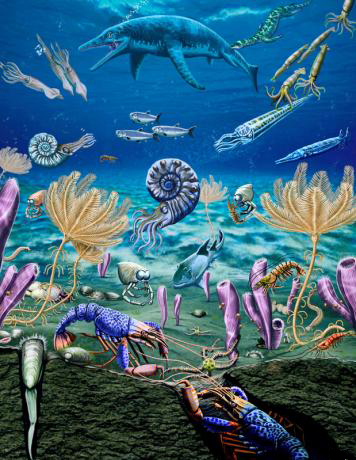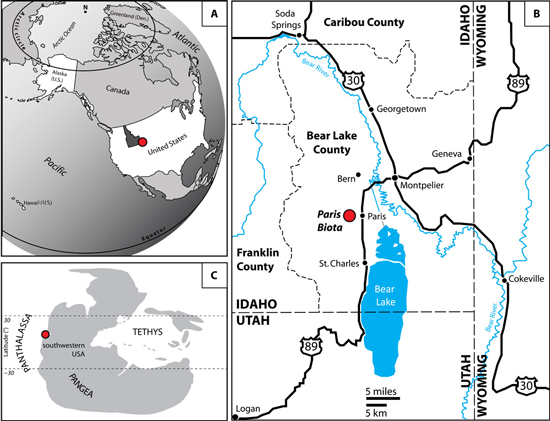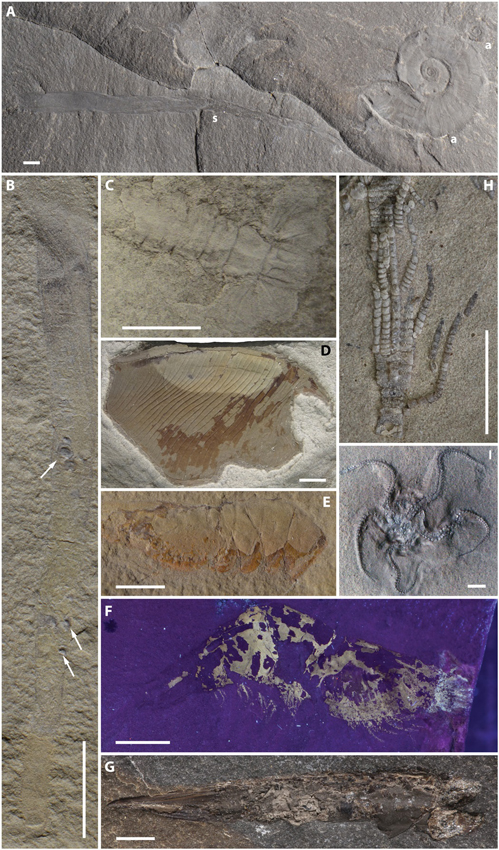An Unexpected Early Triassic Marine Ecosystem
American Fossil Site Shows Diverse Range of Marine Fauna Post Permian Extinction Event
A team of international scientists writing in the on line academic journal “Science Advances” have published details of a complex and diverse Early Triassic marine ecosystem that contradicts the commonly held view that life on Earth was slow to recover from the catastrophic End Permian mass extinction.
An Early Triassic Marine Ecosystem
The fossils of around thirty different species of marine creature have been excavated from shales and limestone near to the city of Paris in Idaho (USA). Four sites in total have been unearthed in Bear Lake County and they represent a marine ecosystem that existed just 1.3 million years after the Permian mass extinction event, the most devastating extinction event recorded in the whole of the Phanerozoic Eon (visible life).
Just 1.3 Million Years After the End Permian Extinction Event a Surprisingly Diverse Marine Ecosystem Thrived
Picture credit: Jorge Gonzalez
A Dynamic Early Triassic Marine Ecosystem
Ammonite and conodont fossils have been used as biostratigraphical markers and the site has been dated to the middle Olenekian faunal stage of the Early Triassic, approximately 250.6 million years ago. The fossils demonstrate that life, at least in some parts of the world bounced back remarkably quickly after the End Permian extinction event that is believed to have wiped out around 95% of life on the planet.
Lead author of the paper, palaeontologist Arnaud Brayard of the University of Burgundy-Franche-Comté (France) stated:
“Our discovery was totally unexpected.”
The Location of the Paris Basin Site (Modern and Mesozoic)
Picture credit: Romano et al (Science Advances)
The picture above shows (A) the site of the Paris Basin in the context of the geography of the United States, (B) a close up of the location of the dig sites (Paris biota) identified by the researchers. Picture (C) shows the approximate position of the Paris Basin during the Early Triassic. The site was very close to the equator during the Early Triassic.
Surprising Fossil Discoveries
The diverse ecosystem consisted of ammonites and other cephalopods, sponges, brachipods and bivalves along with echinoids (sea urchins) crinoids, crustaceans and several vertebrates including marine reptiles, sharks more than two metres long and bony fish.
The Paris Basin ecosystem, included some unexpected creatures. There was a type of sponge previously believed to have gone extinct 200 million years earlier (leptomitid sponges), and a squid-like group (gladius-bearing coleoids), previously thought not to have evolved until the Late Triassic. In addition, the scientists report the finding of bones that could represent the earliest-known ichthyosaur or at least a direct ancestor of an ichthyosaur.
For replicas of ichthyosaurs and other prehistoric animals: CollectA Prehistoric Life Models.
Several other fossils display anatomical characteristics that were thought to have evolved much later (for example, echinoderms), indicating an early and rapid post-Permian/Triassic boundary diversification for these groups as well as previously unknown phylogenetical links between Palaeozoic and Mesozoic taxa.
Brayard added:
“The Early Triassic is a complex and highly disturbed Epoch, but certainly not a devastated one as commonly assumed, and this epoch has not yet yielded up all its secrets.”
Some of the Fossils Representing the Remarkable and Diverse Early Triassic Marine Fauna
Picture credit: A. Brayard, Université Bourgogne Franche-Comté (A to G); T. Saucède, Université Bourgogne Franche-Comté (H); and B. Thuy, Natural History Museum Luxembourg (I).
Analysing the Fossils
The photograph above shows a selection of fossils from the Paris Basin (A) a sponge fossil and ammonites, (B) leptomitid sponge and tiny brachiopods, (C) an ancient lobster, (D) a new genus of thylacocephalan crustacean and (E) shrimp fossil. Picture (F) shows another shrimp fossil depicted under ultraviolet light. Whilst picture (G) shows a Gladius-bearing coleoid, a type of cephalopod that previously, had been thought to have evolved some fifty million years later. A crinoid stem is shown in picture (H) and (I) depicts the remains of a Brittlestar. Scale bars equal five millimetres for all the pictures, except for photograph (B) – scale bar one centimetre.
The researchers conclude that the Paris Biota highlights the key evolutionary position of Early Triassic fossil ecosystems in the transition from the Palaeozoic to the modern marine evolutionary fauna at the dawn of the Mesozoic era.
The scientific paper: “Unexpected Early Triassic Marine Ecosystem and the Rise of the Modern Evolutionary Fauna”, published in the journal Science Advances.
Visit the award-winning Everything Dinosaur website: Everything Dinosaur.




